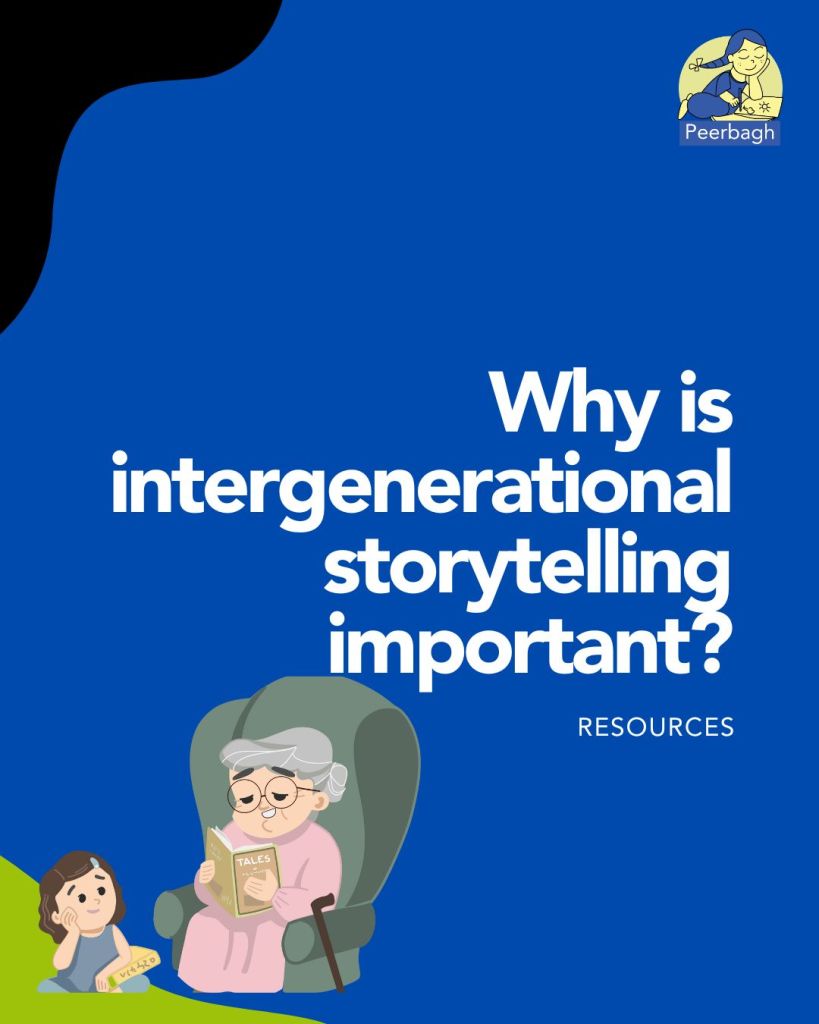“In old stories lies the essence of who we are,
where we come from,
and the values that shape our journey ahead.”
Intergenerational storytelling is an age-old practice with immense value. It is more than just sharing tales; it is about passing down memories, lived experiences, and family narratives that shape the identity and values of the next generation.
Memory Sharing: The Essence of Connection
Imagine the warmth of a family gathering, where grandparents recount tales of their childhood, struggles, and triumphs. These moments are magical for children as they begin to understand the value of their roots. Memory sharing goes beyond mere storytelling. It creates a bond between the past and the present, allowing children to see themselves as part of a larger narrative.
For parents, encouraging these interactions can be a transformative experience. Children become more empathetic and grounded when they hear about the lived experiences of their elders. These narratives create a sense of continuity, helping young minds understand that they are part of a story much larger than their own.
Intergenerational Storytelling
How do you find these stories?
Celebrate
Bento publishes folk stories every quarter. With writing prompts, we encourage families to find their own stories.
Curate
In our Zubaani series, we share curated resources and children’s books for parents and caregivers. Season 1 is LIVE.
Connect
Meeting community members, writers, and artists is a great way to find stories. Varta is coming to Austin soon!
Grandparents: Custodians of Family History
Grandparents play a pivotal role in intergenerational storytelling. They are living archives of family history. They often hold details about ancestors, traditions, and significant life events. When grandparents share stories about their youth, their challenges, and the lessons they learned, they offer a glimpse into the past that no history book can replicate.
For example, a grandmother narrating her experience of migrating to a new city for education or a grandfather recounting how he built his first house gives children a personal connection to history.
These accounts are far more relatable and authentic than statistics in reading materials. Such stories also instill resilience and inspire children to appreciate the efforts and sacrifices of their elders.
You may also be interested in this Zubaani episode
Understanding Origins: Where Your Family Comes From
- One of the most beautiful aspects of intergenerational storytelling is its ability to help children understand where their family comes from.
- Stories of ancestry, cultural roots, and family traditions give children a sense of belonging and pride in their heritage.
- This understanding is particularly vital for children, as they are at a stage where they begin to explore their identity and place in the world.
- Parents and teachers can encourage children to converse with their grandparents about the family’s origins.
- Asking questions like, “Where did our family name come from?” or “What was life like for you as a child?” can open the door to rich narratives and heritage.
Relatability and Authenticity: Why Stories Matter
Personal narratives hold a unique power because they are inherently relatable. Unlike generic stories or historical accounts, these tales are rooted in the real experiences of people children know and love. For example, a grandparent’s story of overcoming adversity can teach children about perseverance in a way that a textbook never could.
The authenticity of these narratives is what makes them so impactful. When a child hears about their grandfather’s first job or their grandmother’s childhood in a different era, it brings history to life. It’s about emotions, struggles, and triumphs that resonate on a deeply human level.
The Role of Lived Experiences in Learning
Lived experiences shared through intergenerational storytelling give children a nuanced understanding of life. For instance, a story about how a family member adapted to significant changes offers lessons in adaptability and resilience. Such narratives also promote critical thinking. When children hear different perspectives, they learn to analyze situations and understand the complexities of human experiences.
Practical Tips for Parents and Teachers
- Encourage Conversations: Create opportunities for children to talk to their grandparents. Family gatherings, video calls, or even school projects can serve as excellent platforms for storytelling.
- Ask Open-Ended Questions: Guide children to ask questions that prompt detailed responses, such as, “What was your favorite childhood memory?” or “How did you celebrate festivals when you were my age?”
- Document Stories: Encourage children to record or write down the stories they hear. This preserves family history and helps children process and reflect on what they’ve learned.
- Integrate Storytelling in Education: Teachers can invite grandparents to share their experiences during special events or lessons, making learning more interactive and personal.
- Celebrate Family Narratives: Parents can create a “story night” tradition, where family members take turns sharing memories, ensuring the practice of storytelling continues across generations.

Intergenerational storytelling is a treasure trove of wisdom. Sharing stories across generations is a timeless way to keep families connected and values alive. It is a gift that enriches young minds with the legacy of lived experiences and continues to inspire future generations.
So, the next time you sit with your children, encourage them to listen to their grandparents’ tales.
This post was written and researched by Peerbagh’s Editorial Assistant, Diksha Sharma. She lives in an Indian city with many parrots.
childrens stories,childrens storytelling,stories for kids,storytelling for children,storytelling in education,storytelling in teaching


